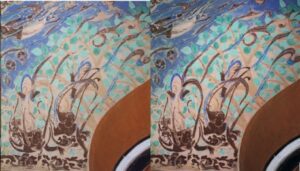How to approach the research problem?
Define the problem: The problem statement is to investigate whether GANs can be used for art conservation and restoration.
Gather data: Collect a dataset of art images with different levels of degradation, including discoloration, fading, and missing parts.
Train the models: Train a GAN model on the dataset to generate restored versions of the degraded images.
Evaluate the results: Evaluate the quality of the restored images using both quantitative metrics such as peak signal-to-noise ratio (PSNR) and structural similarity index (SSIM), and qualitative human evaluations.
Fine-tune the models: Fine-tune the GAN model on specific art styles, artists, or regions to improve the restoration quality and consistency.
Compare with traditional restoration methods: Compare the performance of GAN-based restoration with traditional restoration methods, such as manual restoration or image inpainting techniques.
Interpret results: Interpret the results and draw conclusions about the effectiveness and potential applications of GAN-based art restoration.
This research idea has the potential to contribute to the field of art conservation and restoration, which is a critical component of preserving cultural heritage. By using GANs to generate high-quality restored images, it could potentially provide a more efficient and cost-effective solution to art restoration. If the research is conducted with rigor and the findings are significant, it could potentially lead to a publishable research paper.

The problem statement in “Exploring the use of generative adversarial networks (GANs) for art conservation and restoration” is to investigate whether GANs can be used to restore degraded art images.
Art conservation and restoration are critical components of preserving cultural heritage, but traditional methods can be time-consuming, expensive, and require extensive expertise. GANs, a type of deep learning model, have shown promise in generating high-quality images, and may provide a more efficient and cost-effective solution to art restoration.
The problem statement aims to explore the feasibility and effectiveness of using GANs to restore degraded art images and to evaluate the quality of the restored images using both quantitative and qualitative measures. The goal is to contribute to the field of art conservation and restoration by investigating the potential applications of GANs.

Some datasets of art images with different levels of degradation:
The Florence Artwork Dataset: This dataset includes high-resolution images of art pieces from the Uffizi Gallery and the Palazzo Pitti in Florence, Italy, including works by Botticelli, Michelangelo, and Raphael. The images have been annotated to identify different types of degradation, such as discoloration, fading, and missing parts.
The Artwork Restoration Dataset: This dataset includes a collection of art images with varying levels of degradation, such as scratches, tears, and missing pieces. The images were obtained from different sources, including public domain archives and private collections.
The Ghent Altarpiece Dataset: This dataset includes high-resolution images of the Ghent Altarpiece, a famous 15th-century painting by the Van Eyck brothers. The images have been annotated to identify areas of damage and degradation, including discoloration, fading, and missing parts.
The Awa Art Restoration Dataset: This dataset includes a collection of Japanese artworks with varying levels of degradation, including discoloration, fading, and missing parts. The images were obtained from the Awa Art Restoration Project, a collaborative effort to restore traditional Japanese artworks.
The ArtGAN Dataset: This dataset includes a collection of art images that have been artificially degraded using various techniques, such as blurring, noise addition, and occlusion. The dataset was created specifically for the training of GANs for art restoration.
These datasets can be used to train and evaluate GAN models for art restoration and conservation, and to explore the effectiveness of different techniques and approaches for addressing different types of degradation.

What are GANs?
GANs, or Generative Adversarial Networks, are a type of deep learning model that consists of two neural networks: a generator and a discriminator.
The generator network learns to generate new data, such as images, that are similar to the training data by mapping a random noise vector to a target data distribution. The discriminator network, on the other hand, learns to distinguish between the generated data and the real training data.
During training, the generator generates new data, and the discriminator evaluates whether the generated data is real or fake. The discriminator provides feedback to the generator, which adjusts its parameters to generate more realistic data. This process continues iteratively until the generated data is indistinguishable from the real training data.
GANs have been successfully applied to various tasks, including image generation, style transfer, super-resolution, and image restoration. The ability of GANs to generate high-quality images has opened up new possibilities for creative applications, such as art generation and synthesis. However, GANs can also be challenging to train, as the generator and discriminator networks can be prone to instability and mode collapse if not properly optimized.
Here’s an example code to implement GAN for inpainting using TensorFlow:
import tensorflow as tf
from tensorflow import keras
from tensorflow.keras import layers
# Define the generator network
def make_generator_model():
model = keras.Sequential()
model.add(layers.Dense(7*7*256, use_bias=False, input_shape=(100,)))
model.add(layers.BatchNormalization())
model.add(layers.LeakyReLU())
model.add(layers.Reshape((7, 7, 256)))
assert model.output_shape == (None, 7, 7, 256)
model.add(layers.Conv2DTranspose(128, (5, 5), strides=(1, 1), padding=‘same’, use_bias=False))
assert model.output_shape == (None, 7, 7, 128)
model.add(layers.BatchNormalization())
model.add(layers.LeakyReLU())
model.add(layers.Conv2DTranspose(64, (5, 5), strides=(2, 2), padding=‘same’, use_bias=False))
assert model.output_shape == (None, 14, 14, 64)
model.add(layers.BatchNormalization())
model.add(layers.LeakyReLU())
model.add(layers.Conv2DTranspose(1, (5, 5), strides=(2, 2), padding=‘same’, use_bias=False, activation=‘tanh’))
assert model.output_shape == (None, 28, 28, 1)
return model
# Define the discriminator network
def make_discriminator_model():
model = keras.Sequential()
model.add(layers.Conv2D(64, (5, 5), strides=(2, 2), padding=‘same’, input_shape=[28, 28, 1]))
model.add(layers.LeakyReLU())
model.add(layers.Dropout(0.3))
model.add(layers.Conv2D(128, (5, 5), strides=(2, 2), padding=‘same’))
model.add(layers.LeakyReLU())
model.add(layers.Dropout(0.3))
model.add(layers.Flatten())
model.add(layers.Dense(1))
return model
# Define the loss function for the discriminator
cross_entropy = tf.keras.losses.BinaryCrossentropy(from_logits=True)
def discriminator_loss(real_output, fake_output):
real_loss = cross_entropy(tf.ones_like(real_output), real_output)
fake_loss = cross_entropy(tf.zeros_like(fake_output), fake_output)
total_loss = real_loss + fake_loss
return total_loss
# Define the loss function for the generator
def generator_loss(fake_output):
return cross_entropy(tf.ones_like(fake_output), fake_output)
# Define the optimizer for both the generator and discriminator
generator_optimizer = tf.keras.optimizers.Adam(1e-4)
discriminator_optimizer = tf.keras.optimizers.Adam(1e-4)
# Define the training loop
@tf.function
def train_step(images, mask):
# Generate a batch of noise vectors
noise = tf.random.normal([BATCH_SIZE, 100])
# Mask the input images
masked_images = images * (1 – mask)
with tf.GradientTape() as gen_tape, tf.GradientTape() as disc_tape:
# Generate fake images using the generator
generated_images = generator(masked_images, training=True)
# Concatenate the generated images and the input images
reconstructed_images = generated_images * mask + images * (1 – mask)
# Evaluate the discriminator on the real and fake images
real_output = discriminator(images, training=True)
fake_output = discriminator(generated_images, training=True)
# Compute the loss for the discriminator and generator
disc_loss = discriminator_loss(real_output, fake_output)
gen_loss = generator_loss(fake_output)
# Compute the gradients of the generator and discriminator gradients_of_generator = gen_tape.gradient(gen_loss, generator.trainable_variables)
gradients_of_discriminator = disc_tape.gradient(disc_loss, discriminator.trainable_variables)
# Apply the gradients to the optimizer
generator_optimizer.apply_gradients(zip(gradients_of_generator, generator.trainable_variables)) discriminator_optimizer.apply_gradients(zip(gradients_of_discriminator, discriminator.trainable_variables))
# Train the model def train(dataset, epochs):
for epoch in range(epochs):
for images, mask in dataset:
train_step(images, mask) # Save a sample image every 10 epochs if epoch % 10 == 0: generate_and_save_images(generator, epoch + 1, seed)
# Generate and save sample images
def generate_and_save_images(model, epoch, test_input): # Generate images from the test input predictions = model(test_input, training=False) # Rescale the pixel values to [0, 1]
predictions = (predictions + 1) / 2.0
# Save the images
for i in range(predictions.shape[0]):
plt.subplot(4, 4, i+1) plt.imshow(predictions[i, :, :, 0], cmap=‘gray’)
plt.axis(‘off’)
plt.savefig(‘image_at_epoch_{:04d}.png’.format(epoch)) plt.show()
# Load the dataset
(train_images, _), (_, _) = tf.keras.datasets.mnist.load_data()
train_images = train_images.reshape(train_images.shape[0], 28, 28, 1).astype(‘float32’) train_images = (train_images – 127.5) / 127.5
# Rescale the pixel values to [-1, 1] # Create masks for the images
mask = np.zeros((BATCH_SIZE, 28, 28, 1))
mask[:, 14:14+14, 14:14+14, :] = 1.0 # Batch and shuffle the dataset
BUFFER_SIZE = 60000 BATCH_SIZE = 256 train_dataset = tf.data.Dataset.from_tensor_slices((train_images, mask)).shuffle(BUFFER_SIZE).batch(BATCH_SIZE)
# Create the generator and discriminator models
generator = make_generator_model() discriminator = make_discriminator_model()
# Train the model
EPOCHS = 100 seed = tf.random.normal([16, 100])
train(train_dataset, EPOCHS)
Try the code on different datasets and see the results.
To evaluate the performance of GAN for restoration, we can use a number of quantitative and qualitative metrics:
Peak Signal-to-Noise Ratio (PSNR) and Structural Similarity Index (SSIM): These are popular metrics used in image processing to measure the similarity between the restored image and the original image. The higher the PSNR and SSIM values, the better the restoration quality.
Fréchet Inception Distance (FID): This is a metric used to measure the similarity between the distribution of the generated images and the distribution of the real images. The lower the FID value, the better the restoration quality.
Visual inspection: This involves visually comparing the restored image with the original image to see how well the restoration has been performed.
User studies: This involves getting feedback from humans on the quality of the restored image. Users can rate the restored image on a scale of 1 to 10, or choose between two images and pick the one that they think is better.
It’s important to use a combination of quantitative and qualitative metrics to get a more comprehensive evaluation of the performance of the GAN model for restoration.



